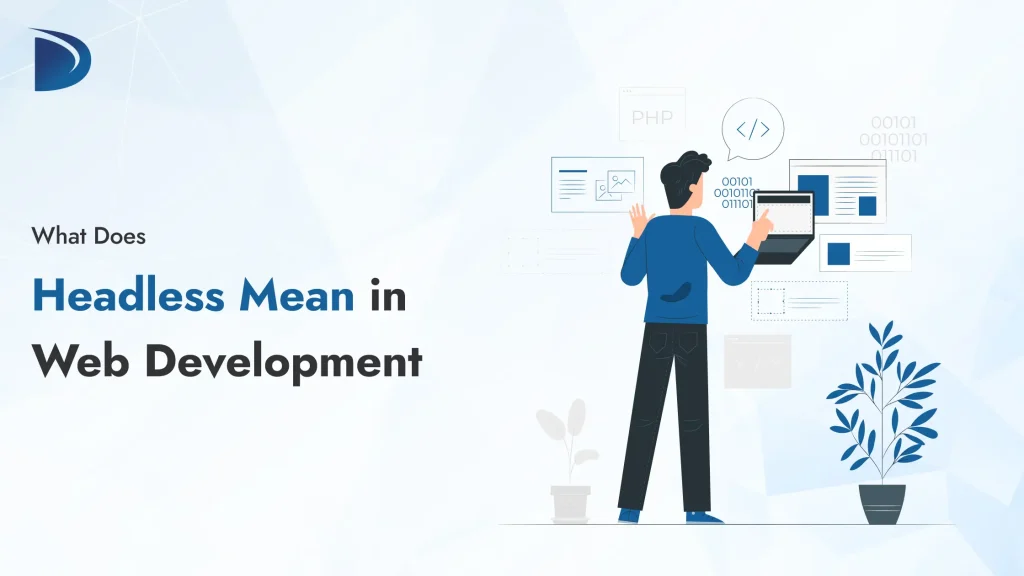Table of Contents
Definition of Headless in Web Development
In a web application, the front-end (what users see in their browsers) and the back-end (the server, database, and application logic) are closely integrated. In traditional setups, website development services often involve both front-end and back-end being tightly coupled. For example, in a CMS like WordPress, the back-end generates HTML, CSS, and JavaScript that are directly served to the user’s browser.
However, to understand what headless means in web development, it’s important to note that in a headless architecture, the front-end and back-end are decoupled, allowing greater flexibility in how and where content is delivered.
In a headless architecture:
- The back-end manages content, data, and logic, but does not dictate how the content is displayed.
- The front-end is decoupled and can be built using any technology, retrieving data from the back-end via APIs (usually REST or GraphQL).
- The “head” (the presentation layer) is removed from the back-end, hence the term “headless.”
A headless CMS, for instance, stores and manages content but delivers it through APIs, allowing developers to use any front-end framework (e.g., React, Vue.js, or Angular) to create the user interface.
How Does Headless Architecture Work?
- Content Storage and Management: The back-end (e.g., a headless CMS like Contentful or Strapi) stores content, including blog posts, product details, and user data.
- API Delivery: The back-end exposes content and functionality through APIs, typically REST or GraphQL, which the front-end can request.
- Front-End Freedom: Developers build the front-end using their preferred tools and frameworks, fetching data from the back-end API and rendering it to users.
- Content Display: The front-end presents data on various platforms, including websites, mobile apps, smartwatches, and IoT devices.
For example, a headless CMS might store a blog post’s title, text, and images. A React-based front-end can fetch this data via an API and display it as a webpage, while a mobile app built with Flutter can use the same API to display the content in a native app format.
Benefits of Headless Architecture
- Flexibility: Developers can utilise any front-end framework or technology, allowing for tailored user experiences across various platforms (web, mobile, wearables, etc.).
- Omnichannel Delivery: Content can be delivered to multiple platforms from a single back-end, ensuring consistency across devices.
- Improved Developer Experience: Front-end and back-end teams can work independently, speeding up development and allowing specialization.
- Scalability: The decoupled nature makes it easier to scale the front-end or back-end independently based on demand.
- Future-Proofing: Since the front-end is separate, it can be revamped or replaced without altering the back-end, reducing technical debt.
- Enhanced Security: Headless systems can reduce vulnerabilities like cross-site scripting (XSS) without direct access to the back-end’s rendering layer.
Challenges of Headless Architecture
- Increased Complexity: Developers need to manage API integrations, which can be more complex than traditional setups.
- Higher Initial Setup: Building and integrating a custom front-end with APIs requires more upfront work than monolithic systems.
- Content Preview Limitations: Previewing content in a headless CMS can be less intuitive for non-technical users without a built-in front-end.
- Dependency on APIs: Performance relies on the speed and reliability of API calls, which can introduce latency if not optimized.
- Cost: Headless CMS platforms and hosting multiple front-ends can be more expensive than traditional solutions.
Common Use Cases
- Multi-Platform Content Delivery: A company might use a headless CMS to deliver blog content to a website, mobile app, and smart TV app using a single content repository.
- E-Commerce: Headless e-commerce platforms, such as Shopify’s headless solution, enable businesses to create custom storefronts while leveraging Shopify’s back-end for inventory and payments.
- Progressive Web Apps (PWAs): Headless architectures pair well with PWAs, enabling fast, app-like experiences on the web.
- IoT and Emerging Devices: A headless system can deliver content to devices like smart speakers or wearables, where traditional CMS rendering wouldn’t work.
Popular Headless Technologies
- Headless CMS: Contentful, Strapi, Sanity, Prismic, or WordPress (with its REST API).
- Front-End Frameworks: React, Vue.js, Angular, Next.js, or Gatsby for building the presentation layer.
- APIs: REST or GraphQL are used to communicate between the back and front end.
- Hosting Platforms: Vercel, Netlify, or AWS for deploying headless front-ends.
Headless vs. Traditional CMS
| Aspect | Headless CMS | Traditional CMS |
|---|---|---|
| Front-End | Decoupled, built separately | Tightly coupled with back-end |
| Content Delivery | Via APIs to multiple platforms | Primarily to a single website |
| Flexibility | High (any front-end technology) | Limited to CMS templates/themes |
| Complexity | Higher (requires API integration) | Lower (plug-and-play templates) |
| Use Case | Multi-platform, custom experiences | Simple websites, blogs |
Conclusion
The headless approach in web development offers unparalleled flexibility and scalability by decoupling the front-end and back-end, enabling developers to create customized, omnichannel experiences. While it comes with challenges such as increased complexity and setup costs, its ability to adapt to modern development needs makes it a powerful choice for businesses seeking to deliver content across diverse platforms. Whether you’re building a website, mobile app, or IoT solution, understanding headless architecture can help you leverage its benefits to create future-proof digital experiences.

